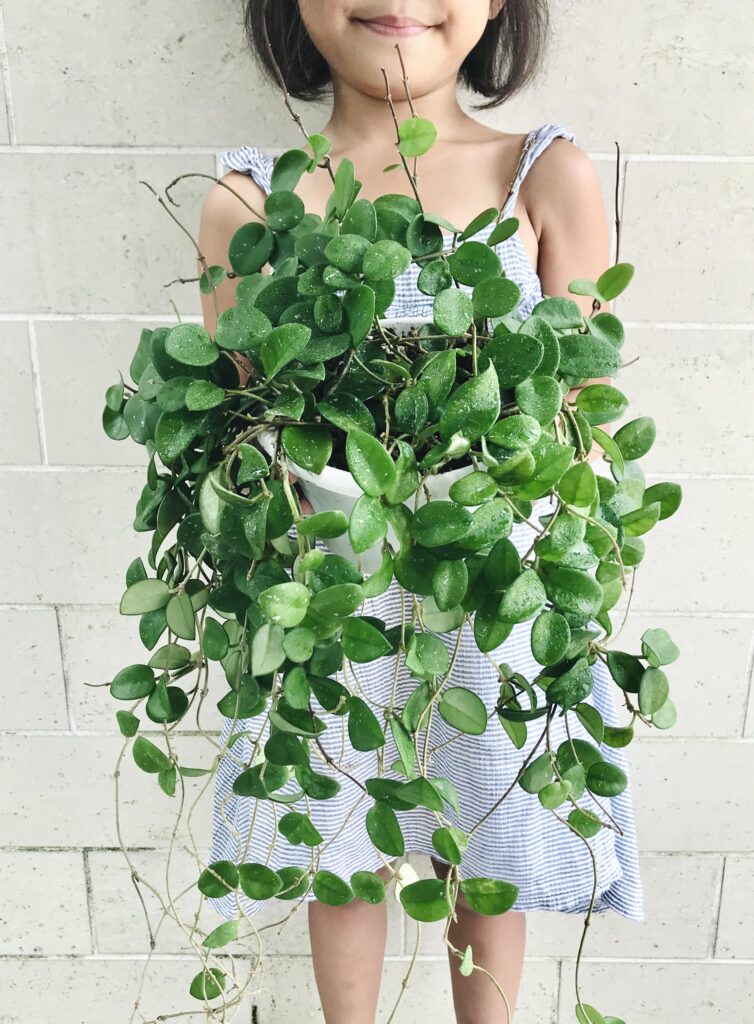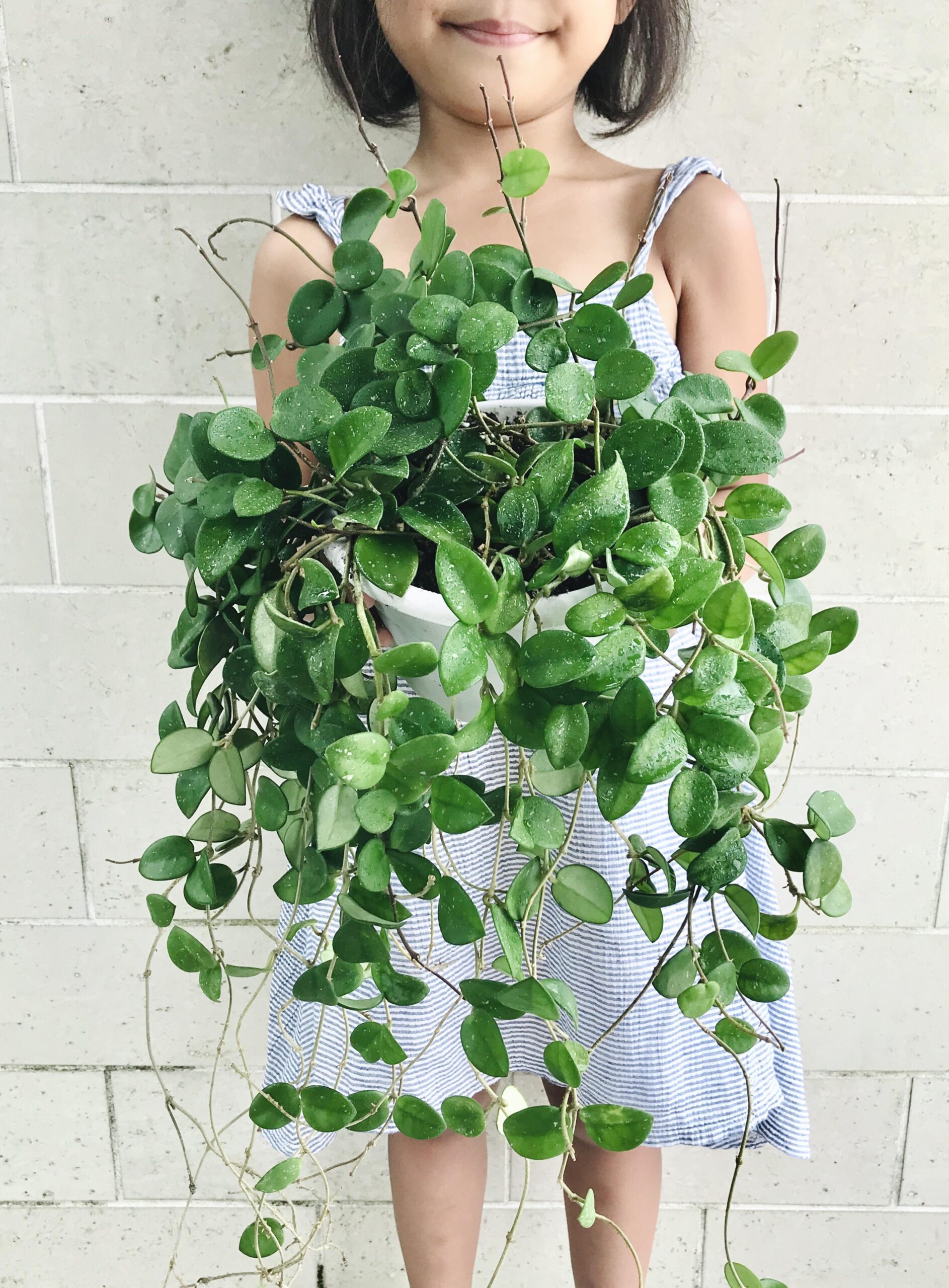Learn How to Grow Hoya Mathilde Indoors and shape the contours of your home elegantly with this gorgeous houseplant.
Hoya Mathilde is perfect for indoor growing; with the right conditions and care, you can easily grow this stunning plant in your home. Read the details about How to Grow Hoya Mathilde Indoors.
Botanical Name: Hoya cv ‘Mathilde’ (Hoya carnosa x serpens)
USDA Zones: 10-11
Read: Hoya Imperialis Care
Hoya Mathilde Information

Also known as Hoya Mathilde Variegata or Hoya Mathilde Splash, this hybrid of Hoya carnosa and Hoya serpens was discovered by Emilio Begine, a plant collector. The name was derived due to the silver speckles on its green foliage.
As an epiphyte, it has small, round leaves with light speckling and a fuzzy texture on their undersides. During warm months, the plant produces clusters of fragrant, fuzzy, white flowers with pink centers.
How to Propagate Hoya Mathilde
Hoya Mathilde can be propagated easily from stem cuttings.
To propagate Hoya Mathilde, divide the stem cuttings as desired. Each cutting should be 3-4 inches long with at least two nodes and 2-3 leaves. Make cuts 1 inch below the leaf node. Leave the cuttings in the air for a few hours to allow callous formation. You can propagate the cuttings in either water or soil.
For soil propagation, insert the cuttings in the soil with one node inside the soil. Water the plant thoroughly and place it in an area with bright, indirect light.
For water propagation, use a clean jar filled with water and dip the cuttings in the water. Change the water every 4-5 days to ensure optimal growth.
TIP: Choose a container with a 4-6 inches diameter for growing Hoya Mathilde.
Read: Hoya Rangsan Care Guide
Ideal Growing Conditions for Hoya Mathilde Indoors

Light
The small green leaves with white specks thrive in medium to bright, indirect light. It’s best to place it near a window where it can receive morning and late afternoon sun, but avoid harsh mid-day sun as it can cause yellowing and burning of leaves.
While the plant can survive in low light, it’s not ideal as it reduces the likelihood of flowering. Good lighting is crucial for flower production, so choose a well-lit spot for regular blooming.
Soil
It is a vining epiphyte that grows in the wild and typically clings to trees. As a result, it prefers lightweight, well-aerated, and well-draining soil when planted.
To create an ideal soil mix for growing Hoya Mathilde indoors, you can prepare it at home using the following recipe: One part orchid mix, one part perlite, half part peat moss, and one-third part organic compost
Tip: You can also add bark, charcoal, rice husk, dried leaves, and grass to make the soil light and porous.
Note: Avoid using heavy, poorly drained soils like clay, as they increase the risk of root rot.
Water
Do not let the plant dry out completely. Also, avoid overwatering. You can check the soil moisture using a soil moisture meter or insert a stick about 2-3 inches deep into the soil and see if it comes out dry. If it does, then it’s time to water the plant.
Another method is to lift the pot and check its weight. If the pot feels lighter than usual, it indicates that the plant needs water.
If possible, use rainwater occasionally, as Hoya Mathilde prefers it.
Tip: Adjust your watering frequency according to the seasons. In hot weather, water it once a week, but reduce it to once every three or four weeks during winter.
Temperature
Hoya Mathilde thrives in warm temperatures. The ideal temperature range for this plant is between 60 and 80 degrees F.
When exposed to temperatures below 55 F, you may notice a slowdown in the plant’s growth.
Humidity
It prefers a humidity range of 40 to 60 percent. If you observe signs of low humidity, such as crisp or brown leaves, you can mist the leaves to increase the humidity around the plant, use a humidifier, or place a pebble tray filled with water.
Read: Growing Medinilla Magnifica Indoors
Hoya Mathilde Care Indoors
Fertilizer
Keep in mind that Hoya Mathilde is not a heavy feeder; providing a slight nutritional boost can be beneficial for the plant’s growth.
During the growing season, it’s essential to fertilize your plant to aid its overall growth. Using slow-release fertilizers like 16-5-11 is recommended to avoid over-fertilization. However, if you can fertilize your plant in the right season, you can also use liquid-soluble fertilizers.
Repotting
This plant does not require frequent repotting, and its flowers bloom better when it is left to grow in the same pot for an extended period. The root system of the Hoya Mathilde is not extensive, and as such, there are no sudden growth spurts for at least a year or two. The appearance of roots from the drainage holes of the pot indicates that repotting is necessary. Therefore, it is recommended to repot this plant only once in about two years.
Pruning
To ensure the proper growth and health of your Hoya Mathilde plant, you may need to trim its vines periodically, especially when they become too long or begin to overlap. It is advisable to cut both the vines and spurs of the plant.
If not trimmed, the perennial spurs can restrict the future blooming of this plant, so it is necessary to cut them before the blooming season.
Pests and Diseases
Indoor settings are usually unfavorable for most pests that attack the Hoya Mathilde plant. However, common pests like Mealybugs, Thrips, Spider mites, and Nematodes may still affect the plant.
If you notice fewer pests, handpicking is ideal. Alternatively, you can use clean or soapy water to spray the affected parts or use 98% Isopropyl alcohol on a cotton ball to kill the pests.
Bacterial blight, root rot, and bacterial wilt are among the common diseases that affect this plant. For root rot, re-potting the plant is the best treatment. To treat both fungal and bacterial infections, use fungicides containing copper or Benomyl.
Hoya Mathilde Toxicity
While the Hoya Mathilde is generally not toxic to humans or pets, it is not safe for consumption, and the sap may irritate if ingested. Therefore, it is essential to keep the plant out of reach of children and pets.



